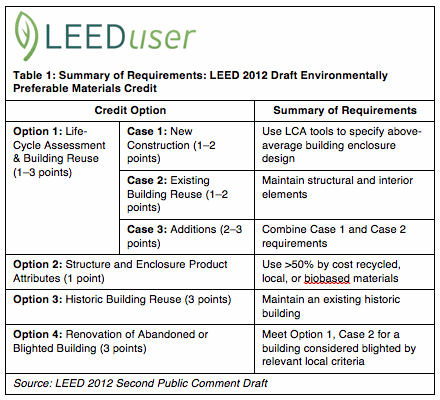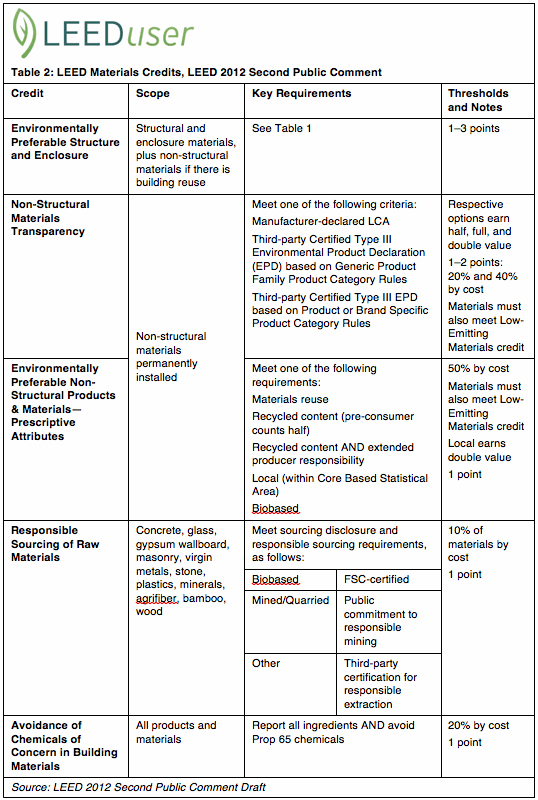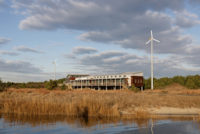Responding to thousands of comments on the first draft, USGBC made major changes to LEED 2012, especially in materials.
A second draft of LEED 2012 is out, and the U.S. Green Building Council (USGBC) is accepting public comments from August 1 to September 14. The new draft and its revisions reflect hundreds of hours of USGBC staff and volunteer time. If a final version of LEED 2012 is approved by USGBC members next year, it will be released around November 2012.
Among the changes to this draft is the name. In its first draft of the new suite of LEED rating systems, USGBC shied away from calling it “LEED 2012,” but this draft officially uses that name. The draft includes changes to all the major LEED rating systems, including LEED for New Construction (LEED-NC) and its companion Design & Construction systems (D&C); LEED for Existing Buildings: Operations & Maintenance (LEED-EBOM); LEED for Neighborhood Developments (LEED-ND); and LEED for Homes.
 |
A life-cycle approach to materials
The new draft is rife with changes, but among those surest to draw attention is an overhaul of the Materials & Resources (MR) section (see Tables 1 and 2). Scot Horst, senior vice president for LEED at USGBC, explains that the section puts new emphasis on both life-cycle assessment (LCA) and transparency by manufacturers. “It’s a transition from where we think the market needs to get to be up-to-date with the rest of the world, and where it is right now,” he says. Horst notes worldwide trends in increased reliance on LCA in evaluating relative impacts of products and materials from extraction to manufacture through use and disposal. Hand in hand with that is increased transparency of what is in products and what the impacts of those ingredients are. Disclosure by manufacturers of LCA data and use of Environmental Product Declarations (EPDs) contribute to credits in the new draft.
The new focus solely on transparency departs from LEED Pilot Credit 43, which was just released in June 2011 to protest from some environmentalists who objected to how it mixed transparency and performance measures (see LEED Pilot Credit to Promote Product Transparency—Not Performance.) USGBC cut loose all of the “eco-label stuff” that caused consternation about the pilot credit, explains Brendan Owens, vice president for LEED technical development at USGBC. “It is now strictly about product transparency,” he continues.
Horst says that the new section also acknowledges the limits of LCA: “While a powerful analytical tool, the information in the assessments is often inadequate at measuring the impacts associated with human health and ecosystem disruption issues,” he says. For that reason, the new draft uses other, more prescriptive credits. An “Avoidance of Chemicals of Concern” credit requires reporting of product ingredients and avoidance of products containing chemicals listed under California’s Proposition 65.
A “Responsible Sourcing of Raw Materials” credit includes requirements for major raw building materials, including wood, concrete, steel, plastics, and glass. Any biobased material would have to be certified to Forestry Stewardship Council (FSC) standards under that credit, and, among other requirements, manufacturers would have to publicly report data on environmental impacts of their operations. The FSC requirement is strengthened from previous versions of LEED: only wood labeled “FSC Pure” would qualify, ruling out “FSC Mixed” wood, in which only a percentage of the product contains FSC-validated content.
At the same time, in a move sure to attract notice from environmental groups, credit for biobased material with or without FSC certification remains in this second public comment draft, in a separate credit. Horst argues that the approach strengthens LEED's leadership position: “If you look at the whole section together, there is increased stringency in the FSC portion, and we’re also saying there are benefits to biobased materials.”
“We are putting out a bold draft with this second public comment—we think it’s a leadership position,” says Horst, clearly hoping that the debate around materials in LEED will broaden beyond the issues that have dominated it for years: certified wood and PVC.
Explaining the new approach, Owens says, “We’re now asking specifiers and manufacturers to engage with multiple issues at the same time—making sure we’re not optimizing one piece of the puzzle at the expense of several other puzzle pieces.” For example, to qualify under the new “Environmentally Preferable Materials” credit, products would not only have to have recycled content or biobased content, or be reused or manufactured locally, but they would also have to comply with the Low-Emitting Materials credit.
LEED-ND split, historic preservation encouraged
Additional highlights in the new LEED 2012 draft include the following.
• To earn the LEED Accredited Professional (LEED AP) credit, LEED APs would have to have a “specialty” credential in the relevant rating system, excluding tens of thousands of those “legacy LEED APs” without such credentials. Horst says there were many comments about the topic during the first comment period. “But for us to not encourage the next level of this credential would be to miss a big opportunity,” he continues.
• Points are now attached to all credits in the LEED 2012 draft through a weighting exercise that took place after the first public comment period. LEED for Homes joins the other LEED rating systems on a 100-point scale.
• LEED for Neighborhood Development (LEED-ND) has essentially been split into two rating systems: one for planned and one for completed projects. “It’s an important step for LEED-ND to be able to serve the market that it was hoping to serve,” says Owens, noting that the changes came as a result of market feedback.
• According to Owens, the credit language for LEED for Existing Buildings: Operations & Maintenance (LEED-EBOM) has been modified extensively to make it align better with how buildings are actually operated, and how data is collected in those buildings.
• Historic buildings get a boost in the Building Reuse credit, with maximum points being awarded to historic projects and renovation of abandoned and blighted buildings.
• A credit calling for extensive measuring of occupant behavior and satisfaction in certified buildings was dropped. That credit has been in the works for a long time, but “We’re having to build the tools in order to get there,” says Horst, and it’s not ready yet.
 |
Detailed guidance and public comment forums
LEEDuser, a website devoted to LEED certification support, has published a credit-by-credit look at key changes to LEED-NC and has posted public forums for discussion of each credit section: www.LEEDuser.com/2012comment.
More information, including revised LEED 2012 drafts, scorecards, and official summaries of changes, are available at USGBC.org.
Disclosure: LEEDuser is a service of BuildingGreen, Inc. the editorial partner of GreenSource Magazine.
Copyright 2011 by BuildingGreen Inc.

Post a comment to this article
Report Abusive Comment